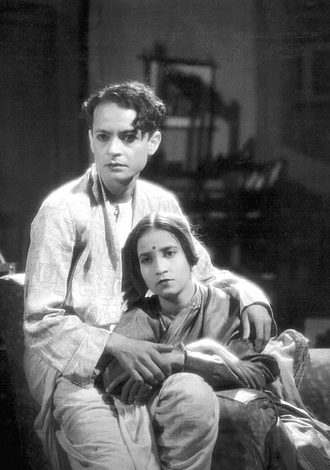Pramathesh Barua

Pramathesh Chandra Barua (24 October 1903 – 29 November 1951) was an Indian actor, director, and screenwriter of Indian films in the pre-independence era, born in Gauripur.[1]
Barua was the son of the royal family of Gauripur (belongs to Gauripur Rajvanch), Dhubri,Assam, where he was born and spent his childhood.[2] He studied at Hare School, Calcutta and then Bachelor of Science graduated from Presidency College, Calcutta[3] in 1924. At age 18, while still studying in college, he got married. It was arranged by the family. He had two more marriages. His third wife was film actress Jamuna Barua. One of his wives, either Madhuri Lata or Amalabala, and singer Meena Kapoor’s mother were sisters. In other words, one of his wives was Meena Kapoor’s aunt. [4] After his graduation, he travelled to Europe, where he received his first exposure to films. After returning, he served for a time in the Assam Legislative Assembly and joined the Swaraj Party but ultimately moved to Calcutta and later began a career in films, much to the chagrin of his father.
Pramathesh Barua’s stepping into the world of films was accidental. He was introduced to Dhirendranath Ganguly during his stay in Shantiniketan. Pramathesh Barua started his film career in 1926 as a member of British Dominion Films Ltd. In 1929, he appeared for the first time on the silver screen in a film named Panchashar which was directed by Debaki Kumar Bose. He also acted in Takay Ki Na Hay, another film directed by Dhiren Ganguly.[5]
Around this time, an actress of silent era named Irish Gasper (Screen Name: Sabita Devi) urged Pramathesh Barua to go independent and build his own studio. Pramathesh Barua wanted to go to Europe and get a practical knowledge of the art and craft of film-making. In 1930, his father Raja Prabhat Chandra Barua sent Pramathesh to England for removal of a kidney stone. After the successful operation, he went to Paris with a letter of introduction from Rabindranath Tagore and met M Rogers. He received thorough training in cinematography in Paris. He learned a lot about lighting in studios at the Fox Studio. He also observed the production of Elstree Studios in London.[6]
He returned to Calcutta after purchasing lighting equipment and set up Barua Film Unit and Barua Studio in his own residence in Calcutta.[7] He then made the first film Apradhi where he was the main lead role and it was directed by Debaki Kr. Bose. Apradhi is a very important film in the history of Indian cinema as it was the first Indian film which was shot under artificial lights. Prior to that Indian films were shot with the help of reflected sunrays. While using artificial lights, he also made necessary changes in the makeup process to suit the lighting. This experimentation led to a wastage of 50,000 feet of ‘picture negative’ and another 1,000 feet of ‘picture negative’ was wasted with experimentation of make-up of artists. Apradhi thus brought radical changes to the technical environment for Directors in Indian cinema.[8]
In 1932, he produced films like Nisher Dak and Ekada. The story of Ekada was written by him and it was directed by Sushit Mazumder. He played villain in the film Bhagyalakshmi which was directed by Kali Prasad Ghosh for Indian Cinema Arts.
